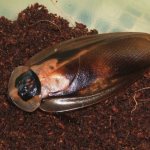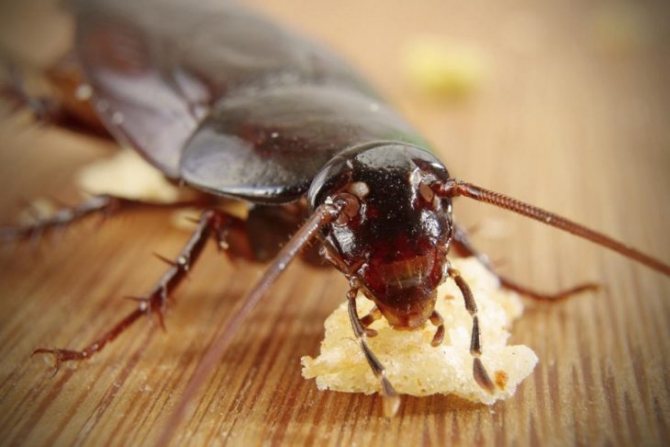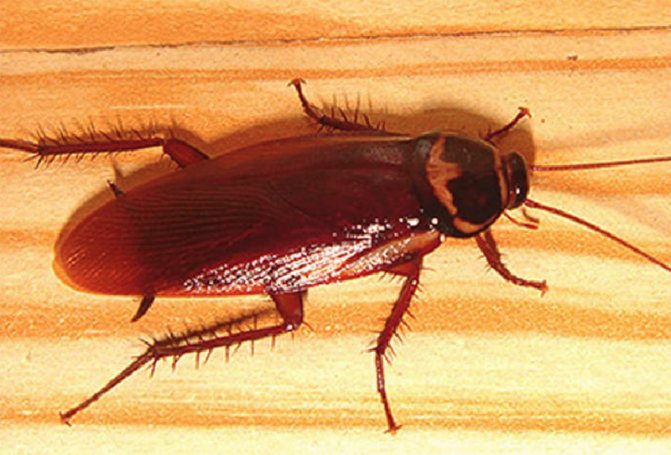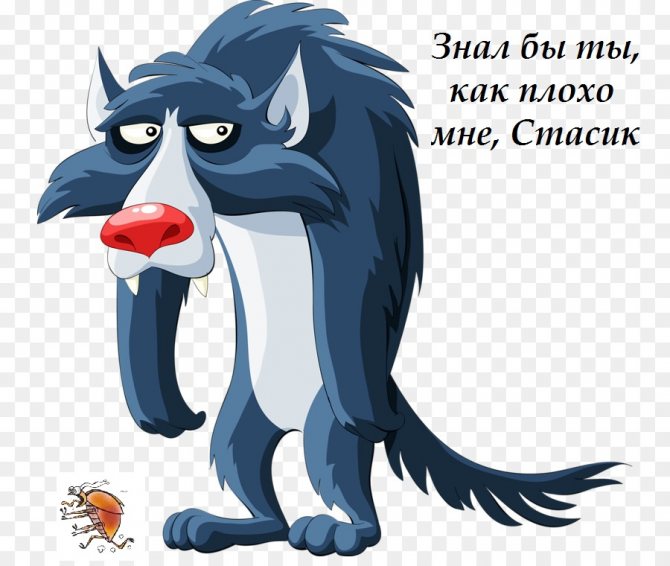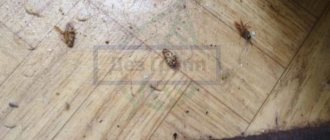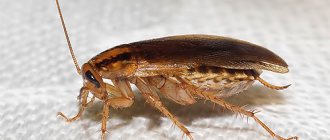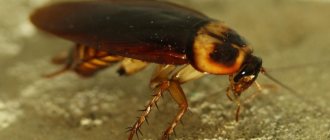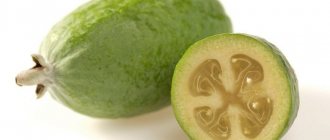20.06.2016
As soon as they do not call cockroaches in different countries of the world: and hares, and Prussians, and felixes, tanchiki, trams, mushrooms. The desire to come up with an offensive nickname is due to a squeamish attitude and fear of mustachioed insects. But, perhaps, the most affectionate and most mysterious is the nickname "Stasiki". Why, after all, Stasiki's cockroaches, let's try to figure it out.
- First version
- Second version
- Third version
- Fourth version
First version
There is an opinion that cockroaches began to be called "Stasiks" after the publication of one anecdote. In this joke, the insect in a squeaky voice was introduced by the name "Stasik". This is where the strange name came from. Most people lean towards this particular version.
Wolf and cockroach
-What is your name, unfortunate insect?
-Stasik ...
- How bad I am, Stasik! The angry wolf said sadly, crushing the cockroach. "
Mustachioed cockroach
According to some sources, the origin of the nickname is due to the mustache of the cockroach. The fact is that the translation of the word "mustache" from different languages of the world is consonant with the name Stas.
Some not particularly competent translator made a mistake in the transcription, and people willingly picked up the original nickname.
- the ending of the Italian word "mustachi" sounds like "-stachi";
- the end of the English word "mustache" sounds like "-stach";
- the ending of the French word "mostaccio" sounds like "-stassio".
By the way, the word cockroach in English looks like "cockroach". It is difficult to imagine that it was possible to make such a gross mistake and draw a consonant parallel between a foreign word and the name Stanislav. But as one of the options, such an opinion can be considered. The version about the Latin roots of the distorted sound is also relevant.
The notorious statistics assure that men named Stas are similar in several ways to cockroaches.
- External signs. It is believed that most Stanislavs prefer to wear a mustache. And since the cockroach is a mustachioed insect, it is this image that pops up in memory at the sight of men with gorgeous hair in the area of the nasolabial triangle. Especially if the mustache is red.
Mustache like a cockroach - Demeanor. Everyone knows how quickly nimble insects hide from the scene of a crime, one has only to flip a switch and illuminate the room with a bright light. So all the same ubiquitous statistics says: Stas's men are energetic and mobile, like cockroaches. So you have to divide one name into two living beings.
Cockroaches scatter
Over time, mankind decided to assign a diminutive-affectionate suffix to insects, and it turned out not rude Stasi, but little mustached cockroaches Stasiki.
Sailors
The sailors borrowed the same word from prisoners and began to apply it to pubic parasites. After some time, the fashion for obscene curses passed and the strong word had to be replaced with something more correct. Here the name Stas turned out to be useful, consonant with an obscene nickname. And later the nickname migrated to other insects, since cockroaches have external similarities to pubic lice. So to this day, men and women shout out the famous modified abusive name at the sight of a nasty insect.
Over the years, people have changed the rough name "Stas" to the more tender "Stasik".A cockroach, although an insect and an unpleasant appearance, it is still harmless, and in some ways even useful. So why not give him an affectionate nickname.
Which version to lean towards is a personal matter for everyone. And how to name uninvited neighbors even more so. Soon, all versions will be combined into one beautiful legend and will be retold in different ways. Or maybe people will learn to live with cockroaches in peace and harmony and forget all-all offensive nicknames.
Similarities with men named Stanislav
In past centuries, the male name Stanislav (short form - Stas) was very common. According to the observations of people, the owners of this name and the "cockroaches" had a lot in common:
- The presence of a mustache. The fashion for facial hair appears cyclically. Previously, the trend was a long, curled mustache. They were looked after, starchy. It is believed that it was Stanislavs who had a weakness for wearing a mustache. Most of them were reddish in color. What cockroaches look like, everyone knows. Their characteristic feature is a long mustache. Perhaps it was this common feature that served the fact that insects began to be called stasiks.
Due to the presence of long whiskers and adaptation to external factors, cockroaches are also called felixes. They owe this to Felix Dzerzhinsky, who was popularly called "Iron Felix".
- There are also some similarities in demeanors. Stanislavs are mobile, active, capable of getting out of the water from any situation. Cockroaches are nimble, run fast. It is difficult to get rid of them, especially considering the scarce arsenal of means that existed before the advent of insecticides. It was for these qualities that pests could receive an affectionate nickname, consonant with a man's name.
Whiskers of cockroaches, as the main feature of insects
Cockroach whiskers prompted people to call insects by other names other than Stasik. So some believe that the nickname "Felix", which is sometimes endowed with cockroaches, insects have earned the resemblance of their whiskers to facial hair that Iron Felix had.
True, linguistic scientists have their own explanation on this, which is as follows. The Latin word "felleus" is translated as "bilious". And our ancestors, trained in Latin, could well call ordinary red cockroaches "felleus" in conversation with themselves. As they would say in our time - just "for show-off." And for the servants or orderlies of scientists, the nobleman "Felleus" could well sound like "Felix".
You can hear how cockroaches are sometimes called "Shura". Why is it so? Perhaps because the German schnurrbart means mustache. And from the German masters, who at a certain period of our history were often invited to Russia to promote European civilization, Russian peasants could hear “Shurik” in the word “shurbart”.
The original scientific names of cockroaches
It happens that nicknames are used not only by ordinary people, but also by entomologists. In addition to scientific names, individual members of the cockroach genus also have nicknames that reflect their characteristics.

- The cockroach, called the "Death's Head", owes its nickname to an ominous black image on its wings.
- The already mentioned rhino cockroach got its name from the protrusion on the shield crowning the cephalothorax.
- One of the types of cockroaches is called "little car" for 2 yellow spot-lights located on the cephalothorax. Their function is to scare off potential enemies.
There are other insects that have additional names, which reflect their special properties.
- "Ash" cockroaches are endowed with gray wings.
- "Banana" live on banana plantations, hiding between bunches of fruits.
- "Furniture" cockroaches prefer all types of materials - wood, and are located mainly in wooden structures.
But hardly any foreign cockroach can compare in the number of names and nicknames with an ordinary Russian or German red cockroach. It is unclear what caused such a multitude of names - whether the irrepressible fantasy of our ancestors, or the morphological features of the Prusak hare, or the vicissitudes of world history. Whatever it was, but the red cockroach, he is a Prusak, a hare, Stasik, a tram, probably will not soon get rid of all his nicknames.
Types of cockroaches in the apartment photo
Prusak - red cockroach
Almost every inhabitant of our country knows a red cockroach, in the photo you see the female (above), and below the male. The name of the species comes from their carapace color - brownish-red.
Males are more slender and more mobile. The favorite place of residence of red cockroaches is the kitchen, where they feed on leftover food. Prusak larvae do not have wings; they differ from adult insects in color and constitution.
Red cockroach larva - photo
It is believed that this species of cockroach was brought to us from Prussia, and in Germany, on the contrary, they are called "Russians". Adult insects reach 10-16 mm in length. It is believed that the Prusak is nocturnal, but recently it can be found at noon right on the table.
“I saw a cockroach at home, and then began to doubt, too small, maybe it's a bug after all? And then I found out that the cockroach has cerci at the end of the abdomen, such small appendages, this is like a rudiment in insects, those who are more developed, in particular the bug, do not have them. Is it true?"
Elena. Yekaterinburg.
Indeed, if you look closely, cerci are visible on the abdomen of the cockroach, which indicates their primitiveness in evolutionary development. Cerci are appendages in the form of segmented filaments; higher insects do not have them at all.
Cerci in cockroaches - photo
Black beetle
Black cockroaches are large and, accordingly, have a coal-black color, they look as if they are varnished. In males, the wings are large, they practically cover the body, in females they are shorter, but the abdomen is wider. Black cockroaches do not fly, although males use their wings to jump further.
Below you see a photo of domestic cockroaches - black (above - male, below - female).
The length of these cockroaches is 1.8 - 3 centimeters. The black cockroach smells unpleasant, the pheromones with which they mark their habitat are to blame, attracting their relatives there.
American cockroach
cannot be considered "home" in the full sense of the word. He lives in nature, but once in an apartment, he easily changes his diet. Outwardly, it looks a little like a Prusak, only "our" is much smaller. An adult insect (imago) is 35-50 mm long and can fly. These cockroaches feed on everything they can, but they give special preference to sweets. The cockroach is aggressive and bites even sleeping people, and the liquid they release is the cause of allergic reactions.
American cockroach in the house - photo
Why are cockroaches called stasiks and what other names are there among the people?


Marine version
It has long been ingrained in the minds of most people that the words cockroach and stasik are synonymous. There are many versions of rewarding the Prussians with an affectionate and euphonious nickname, but the common one is called the sea one.
The reason is marine and prison folklore, and this version, by the way, is confirmed by historical facts. So, prisoners and sailors were often called a strong curse of widespread pubic lice. It was believed that the reasons for the appearance of this infection are people of non-traditional sexual orientation, for whom a rude obscene word was used.
Over time, the use of swear words was deemed unethical.... And the strong curse was replaced by the softer sounding word "stas". Many people call this cockroaches to this day. The diminutive nickname "stasik" is also used.
Moustached version
To explain why cockroaches are called stasiks, you can do this: the nickname was attached to insects in connection with the most important feature - a mustache.
There are two versions:
- In pre-revolutionary times, the male name Stanislav was popular in noble families. The bearers of this name had a thick, lush mustache, which was looked after. In addition, the sneakiness and mobility of Stanislavs was noted among the people, and since cockroaches run quickly, a line of correspondence was drawn between the nimble men and insects.
- The second version is as follows: it was previously believed that the Stanislavs have a bushy mustache. And if they had a red color and a characteristic curl, such men looked like insects.
According to the above versions, the diminutive nickname "stasik" was chosen due to their briskness, long mustache and small size.
Anecdotal version
On the territory of the Soviet space, the anecdote about a gray wolf suffering from a hangover, past which a red cockroach, whose name sounded like Stasik, had the imprudence to run past, enjoyed considerable popularity. The orderly of the forest, in view of his own poor health, swatted the insect, supplying the movement with the phrase "if you knew how bad it is for me, Stasik."
The given version can hardly be considered reliable, since the anecdote was distributed only on the territory of Russia. However, the nickname stasik has long been used to identify cockroaches in Ukraine, Belarus and other neighboring countries. However, this hypothesis has a relative right to exist.
The funny thing is the following: if this option is true, then the choice of the name of the insect by the compiler of the anecdote also depended on how the mustachioed pests will be called in the future.
That is, if the author of the funny story of a cockroach was named Fedenka or Mishenka, these names would be in use to this day. It is difficult to imagine that insects that bring harm to the household are called differently, however, the phrase stasik was not previously mentioned to define parasites.
Double version
The presence of a luxurious mustache in cockroaches can explain the possibility of applying the nickname not only stasik, but felix to them. The explanation is simple. As you know, Felix Edmundovich Dzerzhinsky, a security officer on the territory of the Russian post-revolutionary space, had amazingly luxurious, rich facial hair.
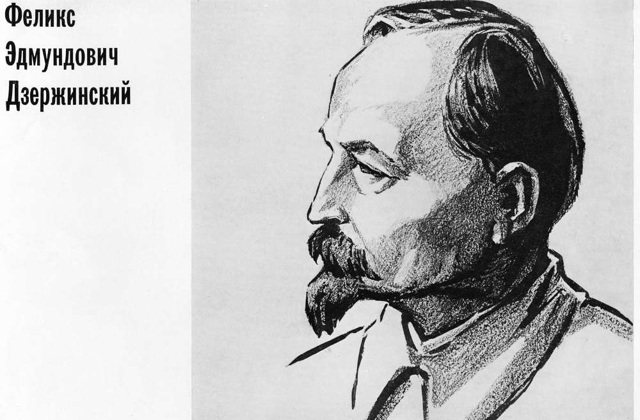

Well-aimed at nicknames, including offensive ones, the people quickly noted this outstanding feature and began to call the name Felix of nasty indoor parasites.
Cockroaches, as mentioned above, are the most common parasites. Even the ubiquitous blood-sucking bugs appear in housing much less often. It is in connection with this prevalence that the people use a lot of different names, each of which is funnier than the other.
The most popular ones:
- Felix. One of the popular nicknames reflects the mood of the people of the post-revolutionary space. Generally hated, the Chekist Dzerzhinsky had a luxurious bushy mustache, which did not go unnoticed. It is thanks to him that parasites are called felixes to this day.
- Prusak. The massive appearance of pests on the territories of villages and cities of the Russian state began during the invasion of Napoleon's troops on their territory, that is, the Prussian troops, this is precisely what caused the name of the parasites. It is difficult to say whether it was the French soldiers who really caused the massive spread of insects, but the fact remains. Before the invasion of Bonaparte, there were no cockroaches in the Russian Empire.
- Russian. The following fact is also interesting - the massive appearance of insects on the territory of France also coincided with the time of the penetration of Russian troops, that is, the French believe that the reason for the appearance of parasites of Russian soldiers.Scientists suggest that in fact this phenomenon is explained as follows: periods of war simply coincided with periods of rapid increase in the population of red cockroaches, which are distinguished by their vitality, are common everywhere.
- Tarasiki. The aristocratic and noble name of cockroaches stas simply did not take root in the everyday life of ordinary people, the name tarasik, which was easier to remember, came. By the way, this nickname is still used to refer to people who are not distinguished by neatness and accuracy.
- Trams, tanks, cars. These names are used in everyday life to the present, it is easy to explain such interesting names. The given nicknames have some similarity in sound with the word cockroaches. In addition, the speed, the speed of movement of the parasites, is of importance.
- Ryzhiks or shura. The given nicknames explain the external color of the red parasites. These names were more often used on the territory of the Soviet space, one of which they enjoy considerable popularity to this day.
- Zhivchiki. The name is popular, but its origin is unknown.
Why Stasiki?
There are several explanations for this name. One of them is based on an anecdote that was once popular.
The wolf sits after a heavy drink, holds its head and moans heavily. At this time, a cockroach crawls past him. The wolf in a hoarse voice asks.
- Who are you?
- Just a cockroach ...
- What's your name?
- Stasik ...
He swatted the gray insect with his paw and sighed with a heavy groan.
- If you knew how hard it is for me, Stasik.
The version is interesting, but not convincing. It is unlikely that on its basis cockroaches were called Stasiks throughout the country. The anecdote is not so funny as to add a new word to the Russian language.
The second explanation has to do with the mustache of cockroaches. Allegedly, once upon a time, men with the names Stas experienced a special love for mustaches, which was reflected in the name of cockroaches. And because of the smallness of insects "Stas" was transformed into "Stasik".
The third version is of a more complex nature, due to the consonance of the name Stas with the not entirely censorship name of the "unnatural" men, by which they are popularly called. When cockroaches really get bored, they are called out of anger by the word that is considered shameful and offensive. Well, when the annoyance subsides, cockroaches can be called affectionately - Stasik.
The latter version is supported by the fact that in the south of Ukraine and Russia, in the common people, Stasiks are called ploshchits - pubic lice. It is widely believed in the navy and "in the zone" that they are most often infected during homosexual contacts. Therefore, the insects were initially called an obscene word, which was later changed into a more politically correct word - "Stas" or more gently - "Stasik". Well, then, by analogy with ploshchits, cockroaches began to be called that way.
There is a point of view connecting the nickname "Stasik" with a cockroach mustache. In many languages the word "mustache" is pronounced in tune with the word "Stasik".
- So, for example, the English "mustache" meaning "mustache" ends with "stach" (almost "Stas").
- The French mostaccio is pronounced mostassio.
- The Italian mustacchi also ends in stachi.
In turn, these words were born from the Greek "mustak", meaning all the same mustache.


Actually, this version is also doubtful, since it is unlikely that the word meaning "mustache", translated by some not very literate reader, was picked up by all people and entered into constant use.
It cannot be ruled out that several versions took part in the origin of the term "Stasik" at once - born of prison folklore, the obscene name of people of a certain group and a favorite anecdote. Somehow, all this was intertwined and transmitted in stories and legends.And linguists now have to unravel the intricacies of folklore, trying to get to the primary source.
Anecdotal version
There is a version that the nickname came from a well-known anecdote. The wolf, tormented after drinking, noticed a crawling cockroach. I asked him what his name was, to which the second replied that Stasik. The wolf crushed the insect out of anger, saying how bad I am, Stasik.
It is thanks to the anecdote that many people call cockroaches stasiks. An interesting fact is that if in the anecdote the insect was introduced as Michael, Slava or another name, then the nickname would come from him. Popular nicknames for cockroaches would be the most unpredictable if fantasy was included.


Black cockroaches (Blatta orientalis)
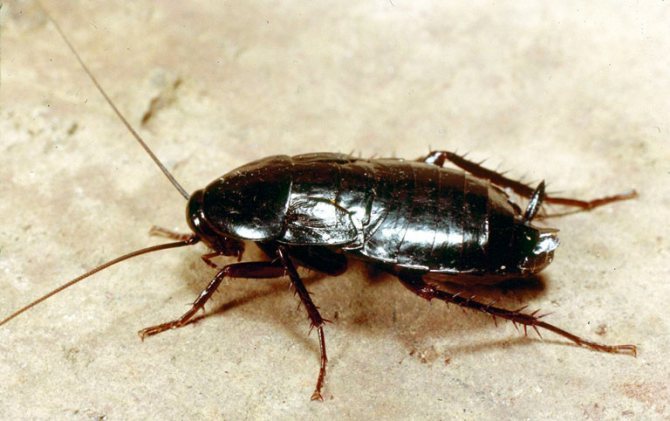

This type of cockroach is quite common where a person lives or where he works. This mainly applies to catering facilities, as well as food production facilities, since they are interested in places where there is enough food. Their favorite places to live are dirty, cluttered basements, garbage dumps or sewers. Therefore, they easily penetrate a person's house or apartment, grocery stores, warehouses, etc. When it's warm outside, they feel quite comfortable in natural conditions, but when it gets colder, they tend to get into the house, because it is always warm here and there is something to profit from.
These insects grow up to 3 cm in length, are distinguished by an unpleasant odor and the presence of a black shell (chitinous layer). Depending on the conditions, their color can have shades, from dark gray to dirty red. This type of cockroach does not multiply so quickly, therefore, timely control of them gives high positive results. If this is not done, then the colony of these pests can become rampant and then getting rid of them is much more difficult.
As a rule, they accumulate in special places, such as:
- Within the bin.
- Within the stove for cooking.
- Behind the refrigerator or kitchen furniture.
- In pantries where food is stored.
Black cockroaches pose a serious danger to humans, since their favorite habitats are places with clear signs of unsanitary conditions. Therefore, it is difficult to even imagine how many bacteria and infections move along with these insects. Since they crawl on food products in the same way, there is a big risk of contracting some kind of ailment.
Life forms
Cockroaches belong to the order of insects with incomplete transformation. That is, during their life, there are only three forms that differ significantly from each other - an egg, a nymph (small cockroaches), an imago.
When mating occurs between a sexually mature female and a male, then immediately after this process, the formation of an ooteca, a kind of chitinous cocoon, begins to occur in the female's sexual sinus, in which the maturation of eggs will continue in the future.
It is noteworthy that the ooteca is very dense; it is protected by the dorsal shields on the last segment of the insect's abdomen. As a rule, the size of the ooteca is quite large and can reach up to 12 mm in length; it can simultaneously contain up to 16 eggs.
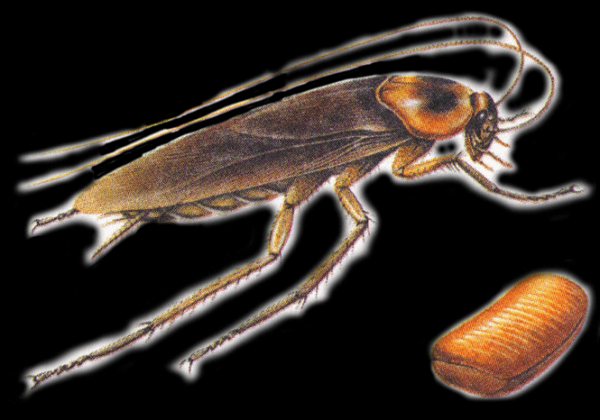

During this time, the female's abdomen gradually increases in size. For several days she carries the ooteca after herself, in the same way taking care of the offspring, but after a while leaves her in a secluded place for the maturation of the larvae. The entire incubation period is 44 days, and after this time, larvae emerge from the cocoon, in appearance resembling adult cockroaches, such individuals are called nymphs, they are white, even transparent in color.
In the future, these small cockroaches darken in the process of molting. In total, they molt about 10 times in their lives, and each time, the nymph becomes more and more similar to their parents - adults, who are called adults.
Where did the "Prusaks" come from in Russia?
In medieval Russian chronicles, there is no mention of domestic insect pests. Historians attribute the first negative statements about them to the middle of the 18th century and are associated with the Seven Years War in Europe, in which Russian troops also took part. Then, in 1757, Austria, France, Russia and Saxony united against Prussia and England. Russian soldiers fought in the Prussian lands with varying degrees of success and went home at the end of the war. And once they were in their homeland, they were surprised to find that their carts, duffel bags, as well as collars and pockets of uniforms were simply teeming with some kind of red insects. The soldiers did not think that they were attracted there by the remnants of meat and bread crumbs.
"Prusaks", as the Russians called them, very soon proliferated in all villages and towns, and they could be seen not only in peasant huts and in an inn, but also in the mansions of noble landowners. Previously unknown insects that did not bite a person and were afraid of him like fire were at first perceived as harbingers of profit. They were even used as a medicine - they were added to vodka, believing that then it would be useful for colds. The peasants came up with a sign associated with them - if the "Prussians" run away from home en masse, then a fire will soon break out. Whether this is true or not is unknown. But it soon became clear that the same food that people eat is also needed for new insects, and the Russians are seriously thinking about how now to rid their homes, taverns and inns of these small parasites.
Prusak or hare?


It is correct to say so and so. Both words appeared in the lexicon during wars of the late 18th century, and finally took hold after the invasion of Napoleon. Until that time, there were cockroaches in Russia, but in small numbers, they were not particularly annoying.
As soon as the Prussian army entered the country, red insects quickly spread to the homes of Russian inhabitants. It is logical to assume that exactly warriors of the enemy army and brought with them cockroaches, so the name clung to them "Prussians".
Almost simultaneously with this, the boots of Russian soldiers stepped onto the territory of Prussia. And immediately spread across the western country cockroaches. Residents of the cities reasonably suggested that the red parasites were brought exactly Russian soldiers, so another name stuck on it - "hare".
But who is really to blame? Don't call us racist, but the true culprits are the gypsies... During the wars, this unscrupulous people began a massive migration, carrying with them myriads of cockroaches.
Stasiks and Prusaks: why were the cockroaches named so and where did the nicknames come from?
Cockroaches have lived near humans for centuries. Among the people, various nicknames and nicknames were invented for these insects, cockroaches became characters in fairy tales, poems, proverbs and sayings.
It is interesting to understand where the common nicknames of cockroaches came from, their various options and interpretations.
In the video, a description of why a cockroach is so difficult to kill:
Cockroaches have a delicate and even gentle nickname - stasik. The only version of the appearance of this nickname does not exist, because people tend to forget about where a particular name came from.
There is an opinion that cockroaches got the nickname "stasiki" for their long mustache. In Russia, the name Stas (Stanislav) appeared after 1917 and immediately became fashionable and widespread.
At that time, many men wore long mustaches, very similar to those for which cockroaches are famous - red, slightly curled and long. By temperament, Stases are dynamic and agile people, full of strength and vitality.
Frisky and fast cockroaches, perhaps got their "human" name because of their mobility and energy.
Another version of the appearance of the nickname is the translation of the word "mustache" from foreign languages:
- French - "mostaccio";
- English - "mustache";
- Greek - "mustak";
- Swedish - "mustasch".
Translated from foreign languages, the word "mustache" resembles the name "Stas".
This version has every right to exist, since the mustache is a characteristic and distinctive feature of domestic cockroaches.
No less common is the version of the appearance of the nickname "stasik" after the well-known "bearded" anecdote about a wolf suffering from a hangover and an annoying red cockroach.
REFERENCE: There are other stories of the nickname "stasik": someone is sure that the sailors called cockroaches this way, and someone thinks that it was invented by people serving sentences behind prison bars.
Even more original is the opinion that the cockroaches were named after the politician Anastas Mikoyan. In the appearance of this food industry worker, in the opinion of his contemporaries, there was something of a cockroach. However, this story has not been confirmed.
Germans and Czechs, on the contrary, consider red cockroaches to be "immigrants" from Russia.
In fact, cockroaches came to Europe and Russia from South Asia and took root in many countries, despite the cool climate.
Prusaks are thermophilic insects that die at temperatures of -5 degrees Celsius. Therefore, pests settle in warm apartments.
REFERENCE: The main cockroach invasion of our country began during the Napoleonic wars.
Prussian soldiers captured a large number of cities and villages in the European part of Russia. Therefore, the local residents might well have formed the opinion that the German invaders brought red cockroaches with them.
In fact, red cockroaches entered Russia and European countries at the same time. The massive spread of pests coincided with large-scale wars. In this regard, the impression was that red cockroaches are a consequence of hostilities.
REFERENCE: The version of Russian peasants, who believe that cockroaches came from Prussia, was confirmed by the famous scientist Karl Linnaeus.
Red cockroaches have a large number of nicknames that were given to them at different times. Insects were often called:
- "Tanchiki";
- "Trams";
- "Tariki";
- "Avtomobilchiki";
- "Ryzhiki";
- "Chewers".
The original nicknames for cockroaches were invented because of their long whiskers.
So, the insects received the sarcastic nickname "Felix" in honor of the main Soviet security officer Felix Dzerzhinsky, who had a spectacular and luxurious mustache.
In German, the word "mustache" sounds like schnurrbart. Germans living in Russia for a long time often called domestic cockroaches Shurbarts. Russian peasants changed this nickname to a more familiar name - "Shurik".
IMPORTANT: Linguists have determined that the word "cockroach" has Turkic roots. In Kazakhstan, the insect was called "kara-khan", which means "black master" or "dignitary"
In Chuvashia, pests are called "tar-gan" - "the one who runs away"
In Kazakhstan, the insect was called "kara-khan", which means "black master" or "dignitary". In Chuvashia, pests are called "tar-gan" - "the one who runs away."
How to get rid of cockroaches at home:
How else are cockroaches called in different countries?
Having a longer history of interaction with humans, the black cockroach is scientifically called the oriental cockroach. In its Latin name - Blatta orientalis - the word blatta means cockroach, orientalis - oriental.
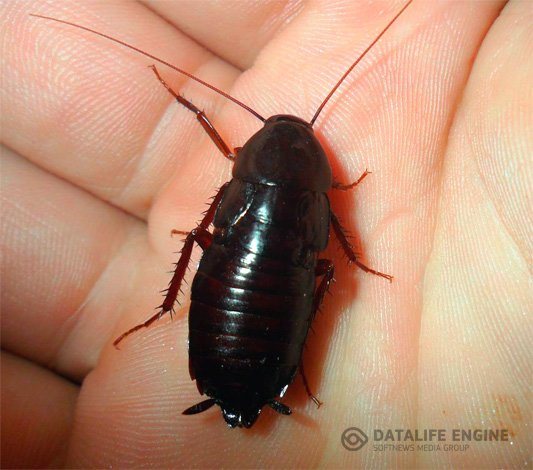

But in Germany and Serbia, the same black cockroach is called German. Its exact name in Serbia is bubashvaba, which translates as "German beetle", although it entered Germany from Asia. 1) American cockroach. This name is inherently incorrect: the insect really began to penetrate into Europe from America, but it also got to America itself during the colonial wars from Africa on ships with slaves;


2) Madagascar cockroach, which is really found in nature only in Madagascar;
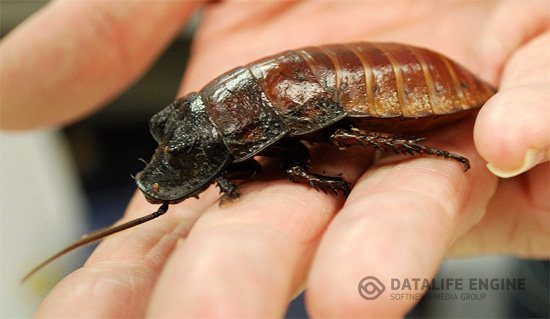

3) Turkmen cockroach living in Central Asia;
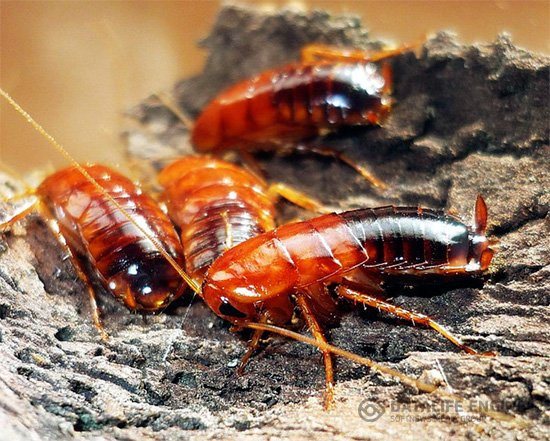

4) Lapland cockroach, distributed mainly in Scandinavia;


5) Australian giant cockroach - originally, as the name implies, from Australia.


However, these are only the official names of these insects. In common parlance, domestic mustachioed pests in Russia alone are called very differently (in addition to the options already discussed above):
- "Tanchikami" - simply because of the consonance of words;
- By "trams" - for the same reason;
- "Chewing" - the etymology of this name is not known.
The very word "cockroaches" has, with the greatest probability, Turkic roots. It was the inhabitants of the ancient Kazakh steppes who called these insects "kara-khan", which translates as "black master". But there are other versions as well. For example, in the Chuvash language, tar-aqan means "the one who runs away", which is very similar to the behavior of cockroaches when a minimal threat appears to them.
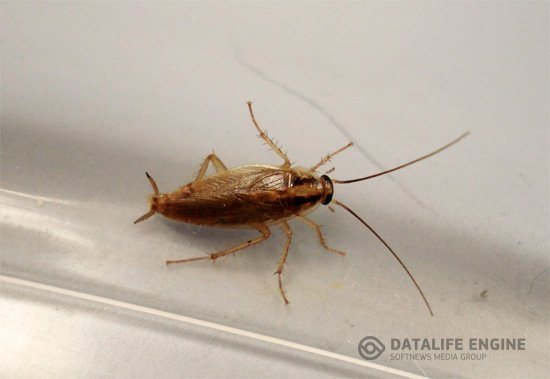

With foreign names of cockroaches, everything is easier. The Latin word blatta comes from Doric and Ionic Greek, which translates exactly as "cockroach". English cockroach comes from the Spanish cucaracha, which was originally called woodlice, and only later - banana cockroaches.
Interesting video: Madagascar cockroach "gives birth" a huge number of small white cockroaches
The main versions of the origin of the nickname "stasik"
A philologist could offer a simple interpretation: from the word "cockroaches" came the joking colloquial name "tarasiki", and from it - "stasiki".
Another version belongs to connoisseurs of urban folklore. Instead of the words "go to the toilet" they sometimes say "go to Stas." The name came up to small insects that took a fancy to the bathrooms.
A joke about the wolf and Stasik
There was no shortage of nicknames, but not all of them stuck in their memory. The name "stasiki" could have survived due to anecdote.
“The wolf suffers from a severe hangover, holds his head and groans. Notices a cheerful cockroach running by. Barely turning his tongue, asks:
- Who are you?
A new acquaintance gallantly introduces himself:
- Stasik, cockroach.
The wolf, with all his anger, slaps the beetle with his paw and howls:
- How bad I am, Stasik!
Red cockroach
Also read - Where did the cockroaches go: the main reasons for the disappearance of cockroaches from our homes
Luxurious mustache
If someone else does not know, "stasiks" are cockroaches, photos of which can be viewed on the site
At first glance, the long antennae on the front of the head attract attention.
The insect constantly wiggles them, leads around. The Russian nickname could appear as consonant with the name of the mustache among the peoples of the world (the French word mustache, the Italian word mustacchio).
Cockroach mustache
Doubtful versions: literary and indecent
In Soviet times, a story was published in one of the popular magazines about a man who, out of loneliness, spoke to a cockroach and gave him the name Stasik. The ending of the story was tragicomic.
The man died, and the faithful Stasik got bored, ran to the old place and wiggled his mustache thoughtfully. This is how a funny name for the insect appeared.
An explanation of why cockroaches are "stasiki" can be found in old urban folklore. It was once believed that pubic lice were transmitted through homosexual contact. In the abusive language for men with a non-traditional sexual orientation, there has long been a swear word.
Also called the pubic parasites. In everyday life, the obscene expression was replaced with a similar name Stas, then the diminutive suffix -ik was added. The nickname stuck with lice and cockroaches.
Read on - Features of reproduction and life cycle of cockroaches
"Black Master" and other names in different countries
To find out what cockroaches are called in other countries, you need to turn to folklore. Most often, the name reflects the population's assumption about the homeland of insects or a description of their appearance. In Turkic “kar” and “khan” means “black master” in translation. The name could mean homage to the black cockroach in the East.
The homeland of the red-headed fellow is Central and South Asia, from where the six-legged travelers arrived in other parts of the mainland. In the middle of the 18th century, they multiplied so much in Germany that the father of biological taxonomy, Karl Linnaeus, used the species name "Germanica" in the description of the species (the modern scientific name is Blattella germanica).
These insects could have entered Russia with goods from Central Asia and China. Red cockroaches were brought in en masse with the transports of the Russian army returning from the seven-year war of 1756–1763. The insects were given the derogatory nickname "Prusaks", comparing with the soldiers of the defeated king Frederick, who was considered an upstart.
In eastern Germany, red cockroaches are called "hare". In Serbia, the black cockroach received the nickname, which means "German beetle" in translation. The names have taken root, although they have nothing to do with the true homeland of insects.
How to get rid of stasiks
Whatever the name of the cockroach, in a rude or petting-diminutive form, it should be remembered that it is dangerous. The pest carries many infections on the paws, its waste products can provoke asthma attacks.
The most effective way to kill insects is to use insecticidal products. One of the safest and most effective for home use is a gel. It is enough to apply the agent on substrates, place them in the places of localization and movement of insects and after 3 weeks there will be no trace of the large colony. Gels are produced by the following brands:
- Clean house;
- Raptor;
- Raid;
- Dohlox;
- Destructive Force and many others.
No less effective are concentrates or powder mixtures, which are diluted with water before use in accordance with the instructions. These drugs show good results with strong contamination of the room. Water-soluble powder Super Fas is allocated from budget funds (not to be confused with Fas Double dust). In the middle price range Sinuzan, Averfos, Sichlor, Tetrix.
Description of American cockroaches
The periplaneta americana's body is rather flat, which allows them to penetrate into various small crevices and holes. Including window and door openings, channels created for electrical wiring, and other shallow holes in the premises. The American cockroach has a very sensitive mustache that allows it to detect food odors or mortal hazards from a distance.
In the daytime, insects are very rare, as they hide in crevices or other dark and humid places where no one will disturb them. But at night they become active and allow themselves to crawl out of shelters and get food.
Thanks to their well-developed teeth, most of all, these American pests prefer to gnaw fresh waste, paper and cardboard products, shoes, cloth, household chemicals, confectionery and various food products (meat, fish, cereals, fruits, vegetables, etc.).
Cockroaches: types, features, how they look and how to distinguish Where do cockroaches leave apartments and why do they appear again Do domestic cockroaches bite How quickly and for a long time to get rid of cockroaches at home
It is worth noting that these pests can be predators and feed on insects, as well as enter the body of animals and parasitize there.
Breeding features
NOTE! To get rid of fleas quickly, there are only three effective options:
- Calling a pest control service (expensive);
- Purchase (1390 rubles);
- Chemicals (questionable effect).
Read more here ...
The entire life of this insect consists of three stages, which stretch for about 600 days. This is an egg, a nymph and an imago. After fertilization, the female carries the future offspring on herself for a day. Then, in a warm, dry and dark place, it postpones swelling.
In thirty days, larvae should hatch from the eggs.Favorable growth and development are greatly influenced by the ambient temperature (25-30 degrees is considered optimal) and high humidity. Individuals most often live in colonies in large numbers.
Harm to humans
The cockroach brings very great harm to a person, especially when it appears in apartments:
- The cockroach carries a large number of viral diseases. A person can become infected from food that has been visited by an insect. If the cockroach does not find food or water, it becomes aggressive and can even bite a person or a pet, which, in turn, will lead to illness.
- The cockroach can cause an allergic reaction. Fifty percent of people with asthma or dermatitis may experience complications from cockroach extract.
- 80% of children may experience various unpleasant symptoms through direct contact with insects.
- Some people experience psychological discomfort with. They develop fear, dislike and even panic.
Despite the fact that American cockroaches most often settle in non-residential premises, they can be found in apartments or houses. These insects are very fond of warmth and moisture and therefore can organize their nests in basements. And from there get into the apartments.
Individuals enter the first floors through cracks, cracks in the floor, open windows and doors. And thanks to their ability to jump and fly high, these pests can easily get to higher floors through ventilation, pipes and risers.
How else do the people call cockroaches?
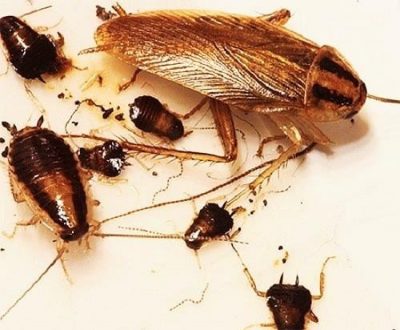

The above is a drop in the bucket from all known popular nicknames. Here are a few more options:
- trams;
- tanks;
- car owners;
- redheads;
- shuriki (a German name that stuck with us);
- shurbarts;
- booby;
- chewing gum.
But do not call a cockroach, but it will no longer be useful. therefore insects need to be poisoned and crushed... Good fit for this Clean House products, sprays, as well as ordinary house slippers!
Where do cockroaches come from?
Prusaks can appear in any room where there is food, moisture, pollution (even small ones in hard-to-reach places), therefore, food industries, residential private / multi-storey buildings often encounter them.
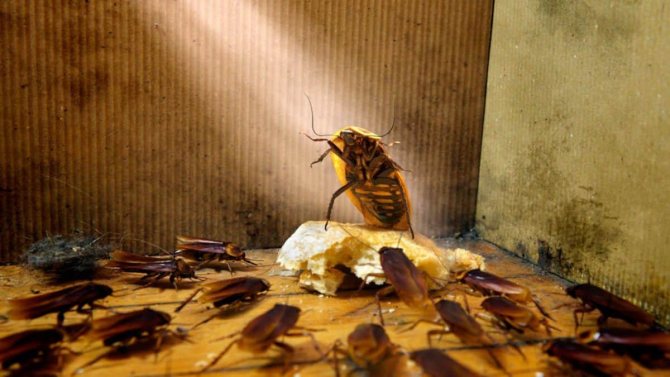

Insects get inside an apartment, house, summer cottage or production in the following ways.
- From neighbors. If there is a house or apartment in the neighborhood with poor sanitary conditions, parasites will climb from there through the garbage chute, ventilation, and cracks in the walls. This usually happens if the Prussians have multiplied strongly and spread to other territories, as well as when they were driven out using harmful insecticides. In the second case, the removal of Prusaks becomes difficult, because the parasites develop resistance to toxic substances.
- Furniture factories and shops can also acquire cockroaches. Along with the purchases, you can bring home an adult or larva, which will soon begin to reproduce.
- Prusaks can often be seen on trains and hostels. They crawl into the bag and come home with the person.
- Today, many cases of transportation of cockroaches by mail are recorded. In the warehouse of the delivery service, Prussians can live, crawling into the box and coming home to the person with the parcel.

